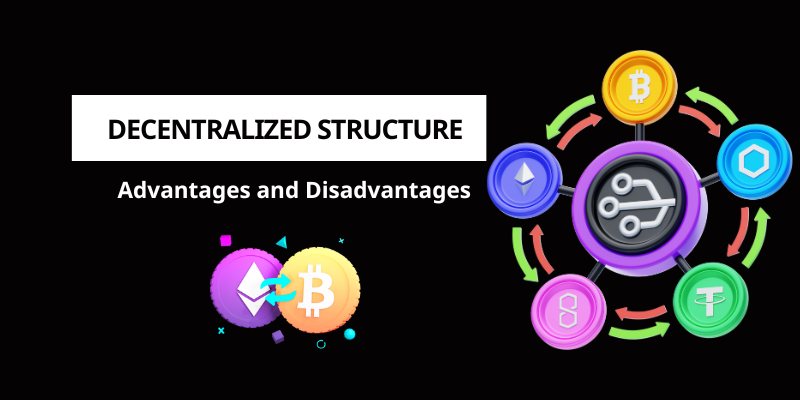In today’s fast-paced business world, organizational structures shape efficiency and success. A decentralized structure has gained traction, but what does it mean for organizations? This article explores the Decentralized Structure Advantages and Disadvantages, highlighting its benefits, challenges, and practical impact.
What is a Decentralized Structure?
A decentralized structure refers to an organizational framework where decision-making authority is distributed across various levels or units, rather than being concentrated at the top. Unlike a centralized system, where a single authority holds power, decentralization empowers lower-level managers, teams, or even individual employees to make decisions. This model is widely adopted in industries like technology, finance (e.g., blockchain-based organizations), and multinational corporations. Now, let’s break down the Decentralized Structure Advantages and Disadvantages to understand its real-world applications.

Decentralized structure Advantages and Disadvantages
Advantages of a Decentralized Structure
- Faster Decision-Making
One of the standout advantages of a decentralized structure is the speed of decision-making. Since authority is delegated to various levels, there’s no need to wait for approval from a central figure. This agility is especially beneficial in dynamic industries where quick responses to market changes are critical.
- Increased Flexibility and Adaptability
Decentralized organizations can adapt more easily to local conditions. For instance, a multinational company with a decentralized structure can tailor its strategies to suit regional markets, enhancing customer satisfaction and operational efficiency. This flexibility is a key highlight among the advantages of a decentralized structure.
- Employee Empowerment and Motivation
When employees are trusted with decision-making power, they feel more valued and engaged. This empowerment fosters innovation, creativity, and a sense of ownership, making it one of the most compelling advantages of a decentralized structure for workforce morale.
- Reduced Burden on Top Management
In a decentralized setup, top executives are relieved from micromanaging daily operations. This allows them to focus on long-term strategy and vision, which is another significant benefit when considering the advantages of a decentralized structure.
- Improved Customer Service
With decision-making closer to the ground level, employees can address customer needs more promptly and effectively. This proximity to the end-user is a practical advantage, particularly in service-oriented industries.
Disadvantages of a Decentralized Structure
While the benefits are notable, the disadvantages of a decentralized structure cannot be overlooked. Here are some challenges organizations may face:
- Lack of Uniformity
A major drawback among the disadvantages of a decentralized structure is the potential for inconsistency. Different units or teams may adopt varying policies or standards, leading to confusion or misalignment with the organization’s overall goals.
- Higher Operational Costs
Decentralization often requires more resources, such as additional managers, training programs, and communication tools, to ensure smooth functioning. This increased cost is a critical point in the disadvantages of a decentralized structure.
- Risk of Duplication
Without centralized oversight, there’s a chance that efforts or resources may be duplicated across departments. This inefficiency can undermine the potential advantages of a decentralized structure if not managed properly.
- Coordination Challenges
Maintaining alignment between decentralized units can be difficult. Poor communication or conflicting decisions may arise, making coordination one of the trickier disadvantages of a decentralized structure.
- Potential for Power Struggles
When authority is distributed, there’s a risk of internal conflicts or competition between units. This can disrupt harmony and productivity, adding to the list of disadvantages of a decentralized structure.
Balancing the Pros and Cons
The Decentralized Structure Advantages and Disadvantages highlight a trade-off between autonomy and control. For organizations considering this model, the key lies in striking a balance. Implementing clear communication channels, standardized guidelines, and robust technology can mitigate many of the disadvantages while maximizing the benefits. For example, companies like Google and Spotify have successfully embraced decentralized elements by fostering innovation while maintaining strategic alignment.
When Should You Opt for a Decentralized Structure?
The decision to adopt a decentralized structure depends on an organization’s size, industry, and goals. Startups and tech firms often lean toward decentralization to encourage creativity, while large corporations may use it to manage diverse global operations. However, weighing the Decentralized Structure Advantages and Disadvantages is essential to determine if it aligns with your specific needs.
In summary, the decentralized structure offers a mix of opportunities and challenges. The advantages of a decentralized structure, such as faster decision-making, employee empowerment, and adaptability, make it an attractive option for modern organizations. However, the disadvantages of a decentralized structure, including potential inconsistencies and higher costs, require careful consideration. By understanding both sides, businesses can make informed decisions to optimize their structure for long-term success.
Visit us for more information!

